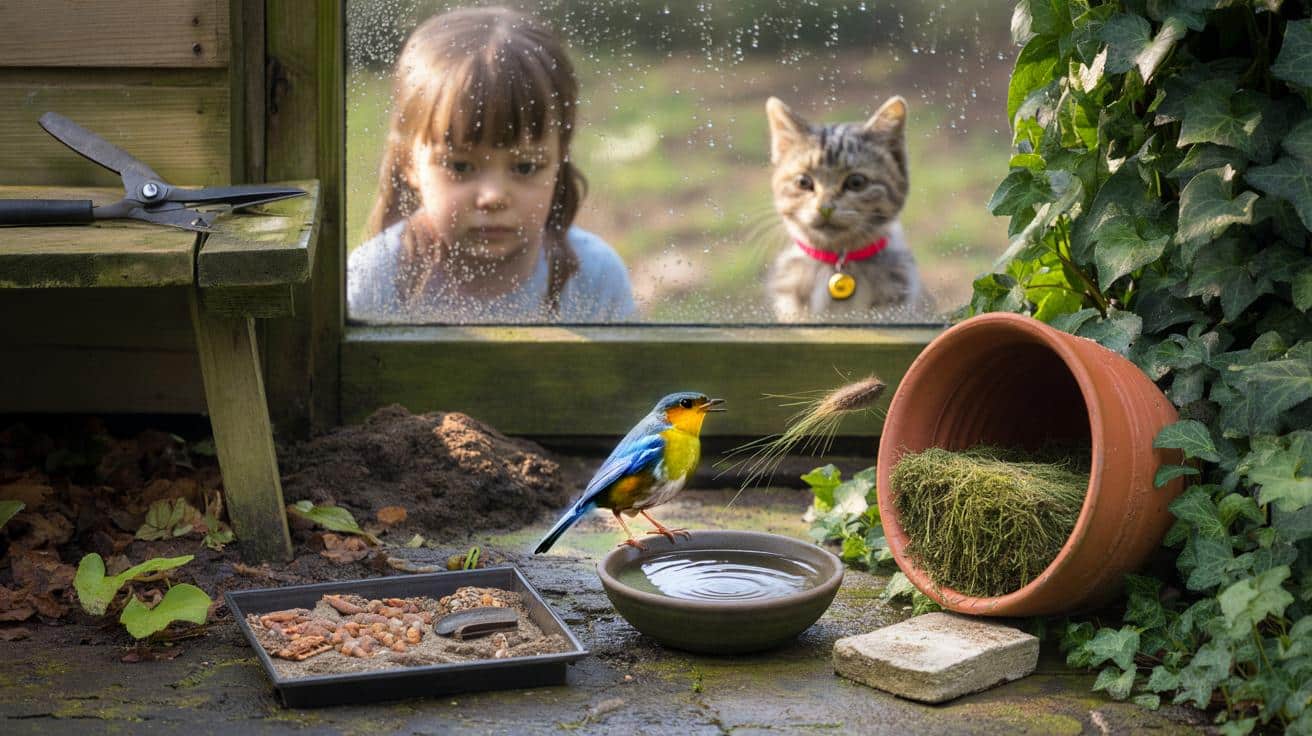Not with grand gestures, but with small, timely moves that make all the difference to a bird that nests low, feeds often, and lives fast. The red-breast is a delight on a grey morning — and a cue to change what we do next.
The robin appeared in the drizzle as the kettle began to rumble, a neat flame of colour against the washing line. It puffed itself round as a button, cocked its head, then vanished into the ivy as if the leaves had swallowed it whole. A child at the window whispered, “It’s back,” and, for a moment, the kitchen became a hide. The compost heap steamed. The cat’s bell chimed once in the hallway. Down by the shed, a clay pot lay on its side, half-filled with moss pulled from the lawn like old green threads. That’s when we noticed it: the robin wasn’t just passing through. It was building a future here. Not somewhere far away. Here.
Why that flash of red matters
Spotting a robin isn’t only a winter postcard moment; it’s a sign your patch is part of a living map. Gardens now cover more land than many nature reserves combined, and robins use them as corridors, pantries and nurseries. **Robins nest low, which means our decisions at ground level can decide the outcome of a season.** A small shift — when we mow, where we place the birdbath, what we leave messy — can protect a brood you’ll probably never see.
Across the UK, estimates point to around six to seven million breeding territories, each one anchored by that sharp, crystalline song. A pair may raise two broods, sometimes three, with four to five eggs per clutch, and chicks that go from helpless to fluttering gaps in under a fortnight. On our street, one family delayed hedge trimming on a hunch after a robin began ferrying fibres into a forgotten welly boot. Weeks later, they watched a ping-pong of beaks on the fence line. Being nosy would have ruined it. Being patient gave them a small summer miracle.
Robins thrive on proximity yet suffer from it too. Strimmers, hedge trimmers and curious pets can undo weeks of hidden work in seconds, especially when nests sit barely a metre off the ground or tucked into a pile of garden tools. Bright sunshine dries out the soil and the worms with it, while unclean feeders swap friendly gatherings for outbreaks of disease. **Disturbing an active nest is against the law in the UK, and it’s also a breach of good neighbourliness with the wild.** When a robin appears, your garden stops being just yours.
What to do the moment you spot one
Create a robin zone that favours safety and easy feeding. Put out live or rehydrated dried mealworms, tiny suet pellets and finely chopped unsalted peanuts — never whole peanuts in spring. Place food low on a tray or ground feeder near cover, not in the open centre of the lawn. Refresh a shallow dish of clean water daily and add a small stone so fledglings can climb out. Keep a messy corner: a mound of leaves, a tangle of stems, a bit of moss. That “imperfection” is a stick-and-mud supermarket.
Common mistakes are usually born of kindness. Moving a nest “to a safer spot” breaks the bond, and hovering for photos can bring predators to the door. Overfeeding bread fills robins up without the protein their chicks need, while dirty feeders turn helpful handouts into trouble. We’ve all had that moment when the strimmer is out and the job is halfway done — pause and scan first. Let’s be honest: no one actually does that every day. Aim for most days. That’s enough to tip the odds.
“If a robin trusts your garden, you’ve already made a difference — now keep the trust.”
- Check before you cut: look low in hedges, ivy and sheds from March to August.
- Keep cats indoors at dawn and dusk, or fit a breakaway collar with a bell and a bright bib.
- Clean feeders and baths weekly with hot water and a mild disinfectant; dry thoroughly.
- Offer water every day in hot spells and after frost; shallow, with an easy escape.
- Avoid loose netting, sticky traps and harmful pesticides; go for gentle, wildlife-friendly options.
- Stick window decals on large panes to cut collisions in bright weather.
- Never move an active nest; if it’s in a risky spot, cordon off the area until the brood has fledged.
- If you find a sick or injured bird, contact a local wildlife rescue; follow current UK guidance before handling.
A season you can share, quietly
Helping robins isn’t a grand project; it’s a handful of small rituals noticed by the kids, the neighbours, and the morning brew. It starts with remembering that a hedge is a home, not just a line. It grows into a rhythm — feed, clean, pause, listen — woven into your week like taking the bins out or checking the post. *The little red-breast isn’t just cute; it’s a responsibility we can hold lightly and do well.*
There’s a hush that falls when a fledgling makes the first clumsy hop from the ivy to the chair, then to the fence, then — gone. That moment belongs to the bird, but it also belongs to the people who chose to wait rather than tidy, to water a saucer rather than a hanging basket. **A shallow dish of water can be the difference between life and death in a heatwave.** Share the habit, not the location. Talk about the song, not the nest. The story lands better when it ends with flight.
| Key point | Detail | Interest for readers |
|---|---|---|
| Pause the tools | Scan low hedges, ivy and sheds March–August; robin nests are often at knee height | Prevents accidental nest damage and heartbreak |
| Feed for protein | Offer mealworms, suet crumbs and chopped nuts; avoid whole peanuts in spring | Gives chicks the nutrients to grow fast and strong |
| Water and hygiene | Daily fresh water; weekly feeder clean with hot water and mild disinfectant | Cuts disease risk and supports birds in heat or frost |
FAQ :
- What should I feed robins during nesting season?Go for protein-rich foods: live or soaked dried mealworms, small suet pellets and finely chopped unsalted peanuts. Offer them low and near cover.
- Is it illegal to move a robin’s nest?Yes, moving or disturbing an active nest is an offence under UK law. Wait until the brood has fledged, then adjust the area for next season.
- How can I protect robins from my cat?Keep cats indoors at dawn and dusk, fit a quick-release collar with a bell and consider a bright bib. Place feeding stations away from ambush cover.
- I found a chick on the ground. What should I do?If it’s feathered, it may be a fledgling with parents nearby. Keep pets away and watch from a distance. If it’s unfeathered or injured, seek advice from a wildlife rescue before intervening.
- Should I clean my bird feeders, and how often?Yes — once a week in warm weather, fortnightly in cooler spells. Use hot water and a mild disinfectant, rinse well and dry fully before refilling.









